Concierge
This covers only Moveworks ClassicFor Moveworks Copilot experiences, refer to "Moveworks Copilot - Feature Overview" page.
Overview
Concierge is a Moveworks skill designed to accelerate the resolution of tickets by providing the ability to interact with support tickets in-chat by performing common ticket actions such as: adding comments, resolving tickets, etc.
In addition to ticket actions, Moveworks Concierge keeps end users updated on their tickets. The Concierge skill integrates with your organization’s IT Service Management (ITSM) systems, or HR Case Management systems, and can even be integrated with multiple ITSM or HR Case Management systems to support your organization’s needs.
Concierge is made of a few key features:
- Ticket Notifications — keep employees informed of key updates to their support tickets
- Creating / Filing Tickets — allow users to raise new tickets to your service desk(s)
- Viewing Tickets — allow users to lookup details about their latest tickets
- Adding Comments to Tickets — allows users to respond to agents on their tickets
- Resolving Tickets — allows users to resolve their tickets when their issue is solved
- Reopening Tickets — allows users to reopen their tickets when their issue persists
- Multi-Domain Concierge — allows users to pick the right service desk to contact when creating a ticket.
Ticket Notifications
Ticket updates
The Moveworks bot can notify users when key updates are made to a ticket. The key updates that the bot will notify the requested_for user about are:
- New comment added to ticket
- Ticket marked as (waiting for user) accompanied by a comment
- Ticket marked as solved
New comment added to ticket
If a new comment is added to a ticket, even if there is not a state change, the Moveworks bot will notify the user that a comment has been added.
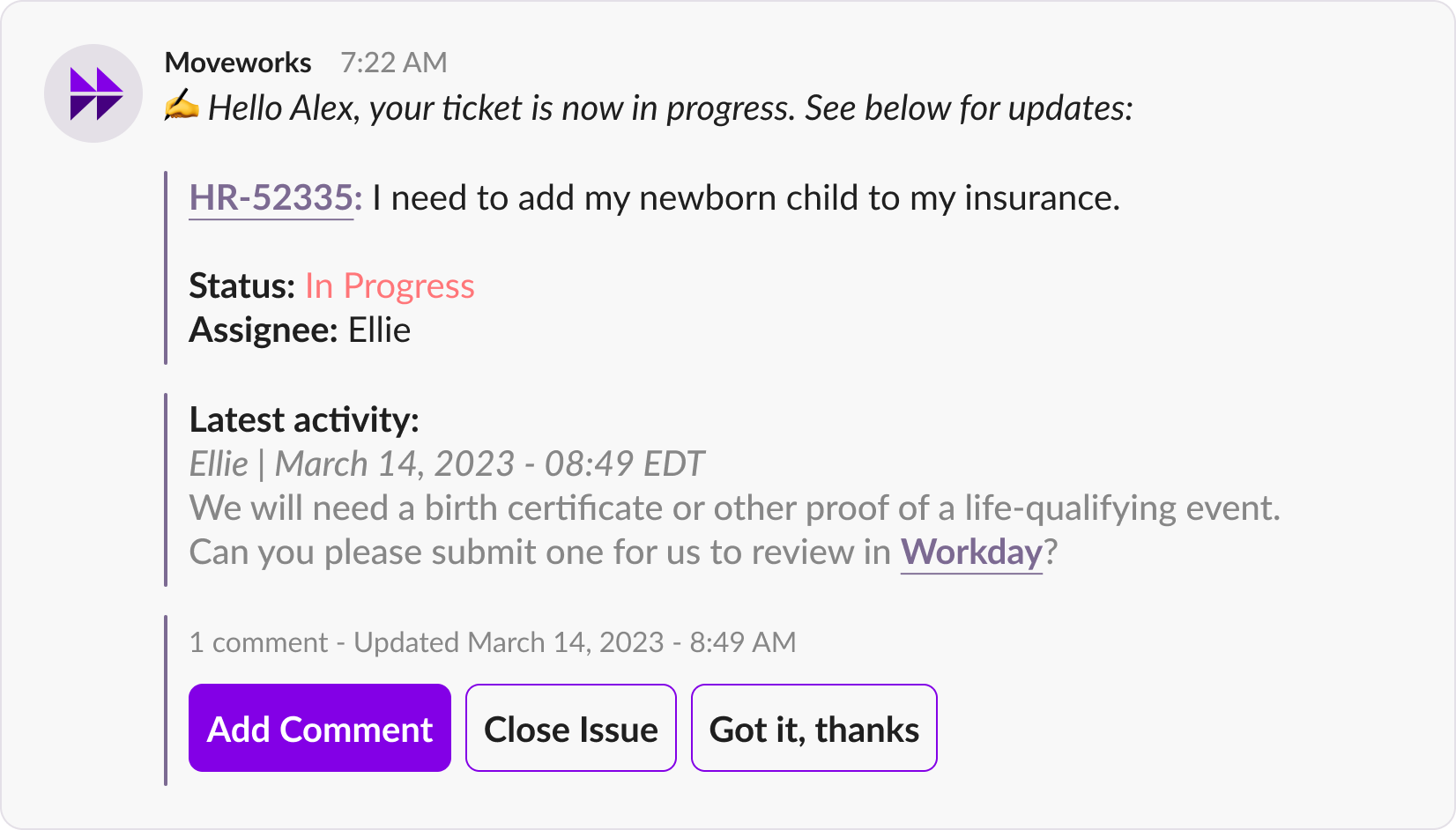
Note: Assignee field can be hidden if desired.
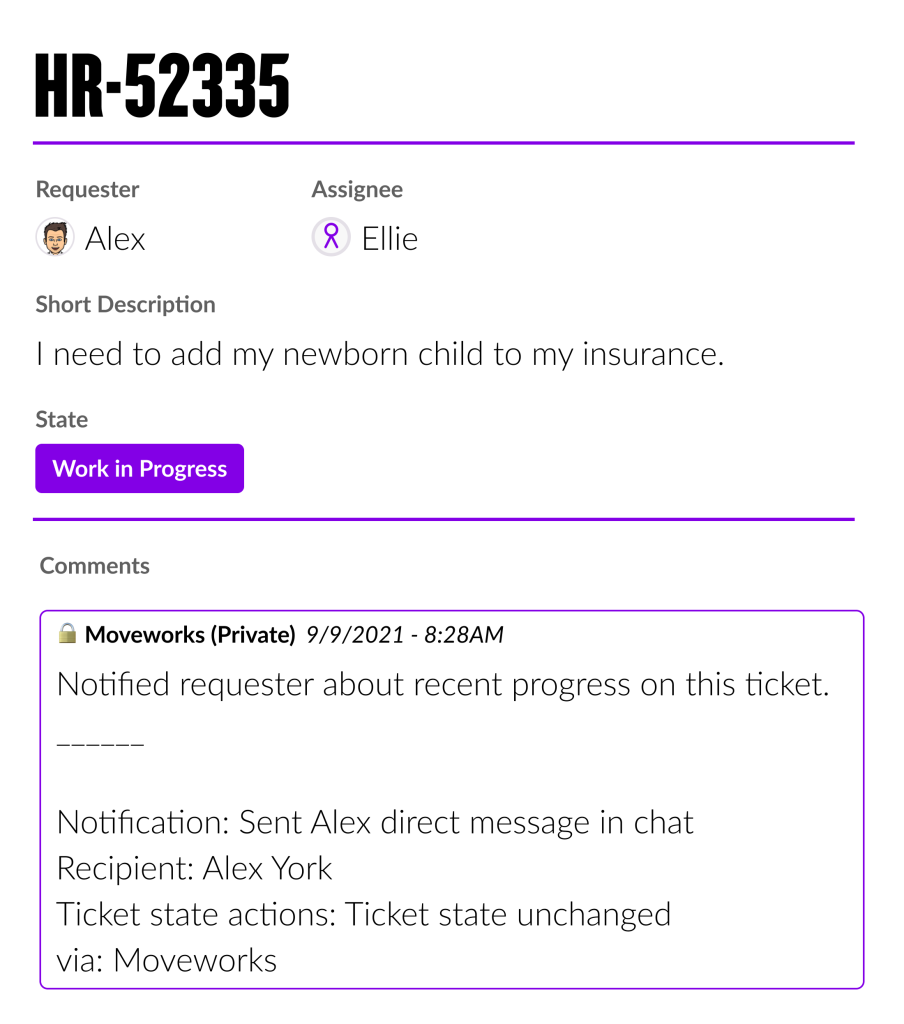
The bot also leaves an audit note in the ticket comments, letting agents know the user has been notified.
Significant status change to ticket
A significant status change occurs when:
- The ticket type is an Incident and the state is changed to
Resolved. - The ticket type is a requested item (RITM) and the state is changed to
Closed. - The ticket state is changed to
Waiting for User. - The ticket state is changed to
Canceled.
Introductory Messages
The introductory message to the employee after “Hello {name}” will vary based on the current ticket state of the ticket. These messages are outlined below:
State | Introductory Message | Actionable Buttons Shown |
|---|---|---|
| Hello {name}, your issue will be addressed shortly |
|
| Hello {name}, your ticket is now in progress |
|
| Hello {name}, {Agent Name} is waiting for your response |
|
| Hello {name}, we are waiting for your response |
|
| Hello {name}, your ticket has been cancelled |
|
| Hello {name}, your ticket has been resolved 📝 If available, Resolution Notes, also known as Close Notes, are shown under the “Latest Activity” section instead of the most recent comment |
|
| Hello {name}, here's an update on this ticket |
|
Note: The word ticket can be configured to something else, in case your organization uses a different term.
Ticket Nudge
The Ticket Nudge skill ensures that tickets are not lost in the shuffle by reminding users of their open tickets. When a ticket’s state is New or In Progress with no new user-facing comments for a certain amount of days, the bot will reach out to the user. The amount of days with no new comments can be configured during implementation. By default the bot will reach out to a user after three days with no update. The bot will also reach out to a user with a Ticket Nudge a maximum of ten times by default. The amount of time with no update before a notification is sent and the maximum number of notifications a bot sends is both configurable.
Ticket Nudge reach out
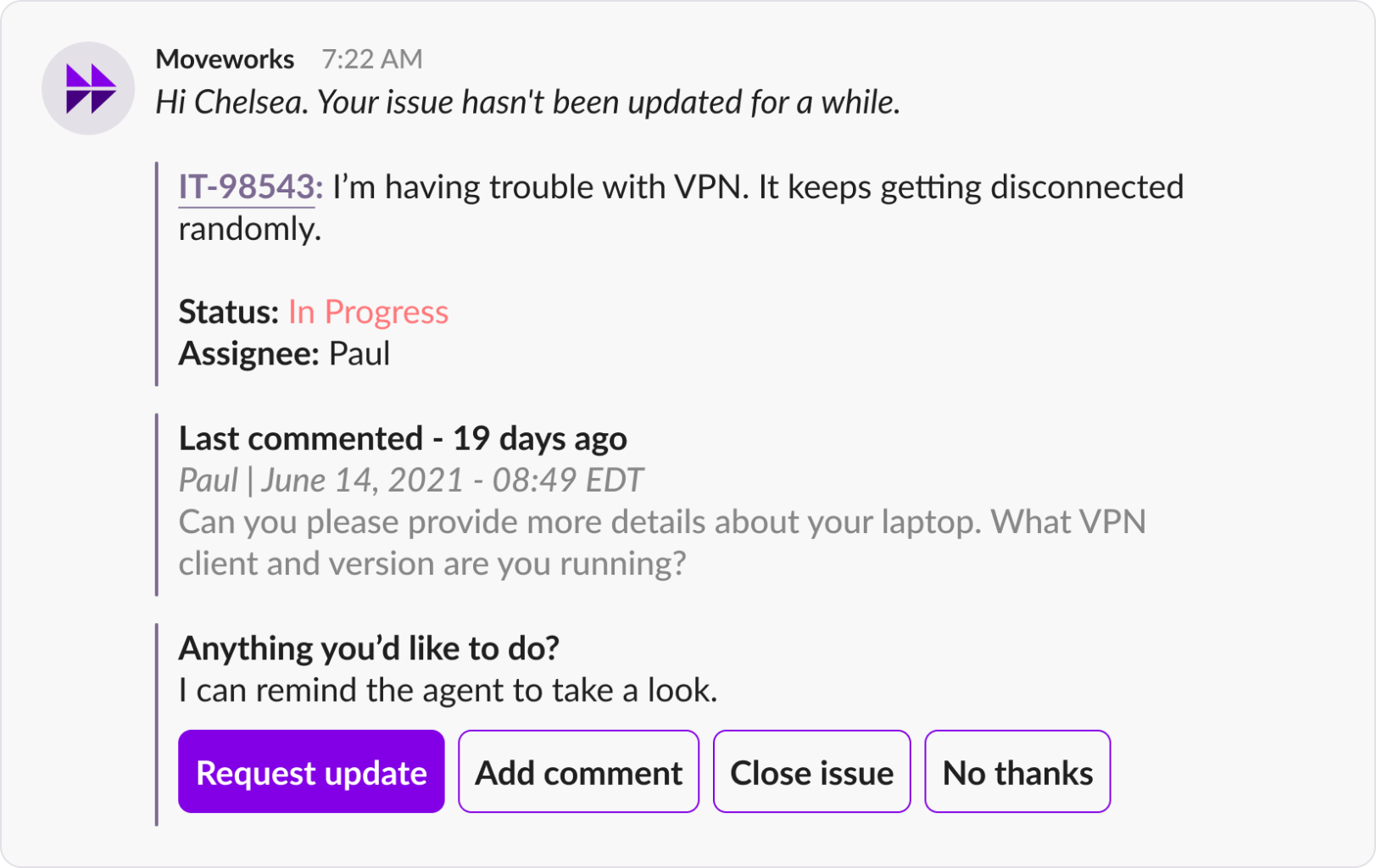
The bot will also leave a comment in the ticket saying it has reached out to user due to a lack of recent activity on the ticket in the past few days.
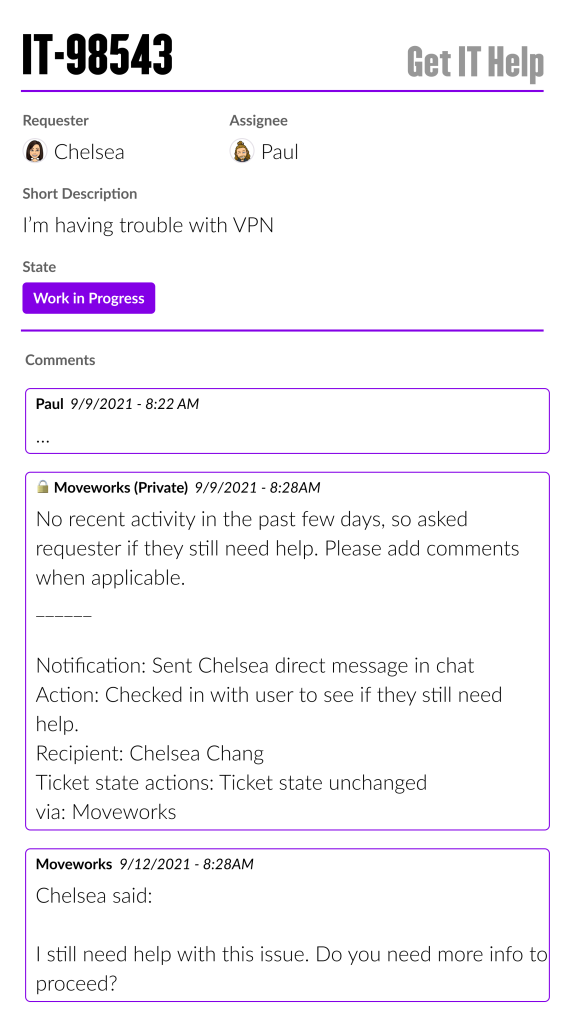
Actionable buttons
Request update
Users can click on Request update to add a comment to the ticket to remind the support team that they still need help with their issue.
Configuration options
Watcher Notifications
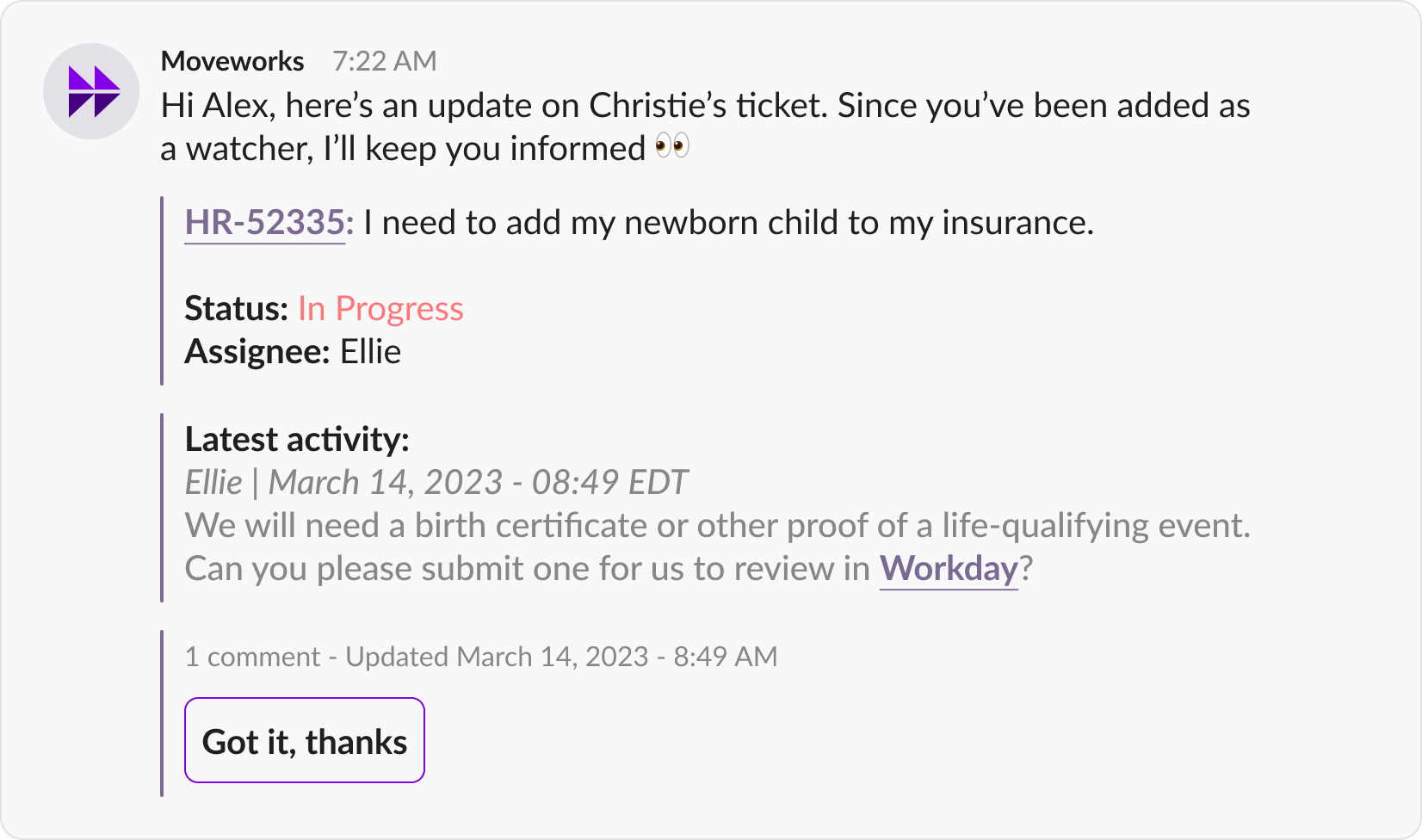
When integrated with ServiceNow or Jira Service Desk, Moveworks can also notify relevant watchers on the ticket with the same notification dialog, but the Moveworks bot will not render ticket actions (comment/close) for those users.
Ticket Nudge Timing
Three days is the default duration of time without a user-facing comment that results in a Ticket Nudge. The duration of time without any updates before a Ticket Nudge is sent is configurable to any number of days.
The amount of days the bot will nudge users for is also configurable. For example, the bot can be configured to nudge the user about a ticket for three days and then it will stop notifying the user.
Maximum amount of Ticket Nudges
By default, the Moveworks bot will reach out to a user with a Ticket Nudge a maximum of ten times. The maximum amount of times the bot will reach out is configurable. For example, the bot can be configured to nudge the user three times at maximum before stopping.
Ticket Nudge Filters
You can choose certain tickets which will NOT be subject to ticket nudges. You can use this to disable nudges on tickets that generally don’t need input while waiting. Common Attributes to filter on include:
- Assignment Group
- Category
- CMDB
- Component
- requested_for
Business Hours
You can configure ticket notifications to only be sent during a user’s business hours.
Note: Calculating Timezone in MoveworksMoveworks requires timezone information for each user in order to be configured to only send ticket notifications during user’s business hours. Moveworks calculates timezone by:
- Initially, combining the city and country code to find a direct match.
- If no match is found, it considers the state.
- Following that, if still unresolved, it examines the country code alone.
- Lastly, the region is checked as a fallback option.
This prioritized approach enables Moveworks to accurately assign the appropriate timezone, efficiently handling varying levels of location detail provided.
Weekend Support
You can configure Concierge ticket notifications to only be sent during weekdays.
Unsubscribe
The Ticket Notifications Unsubscribe feature allows end-users to control which level of notifications they receive regarding updates on their IT tickets.

When the user receives a ticket notification or checks the status of their tickets, the user will see a button for Notification Settings. Once a user clicks on the button, they will be presented with the option to:

- Mute for 7 days - turns off the bot notifications for 7 days on Concierge updates
- Unsubscribe - turns off notifications for Concierge updates
If a user desires to turn ticket notifications back on, the user can do this in two steps:
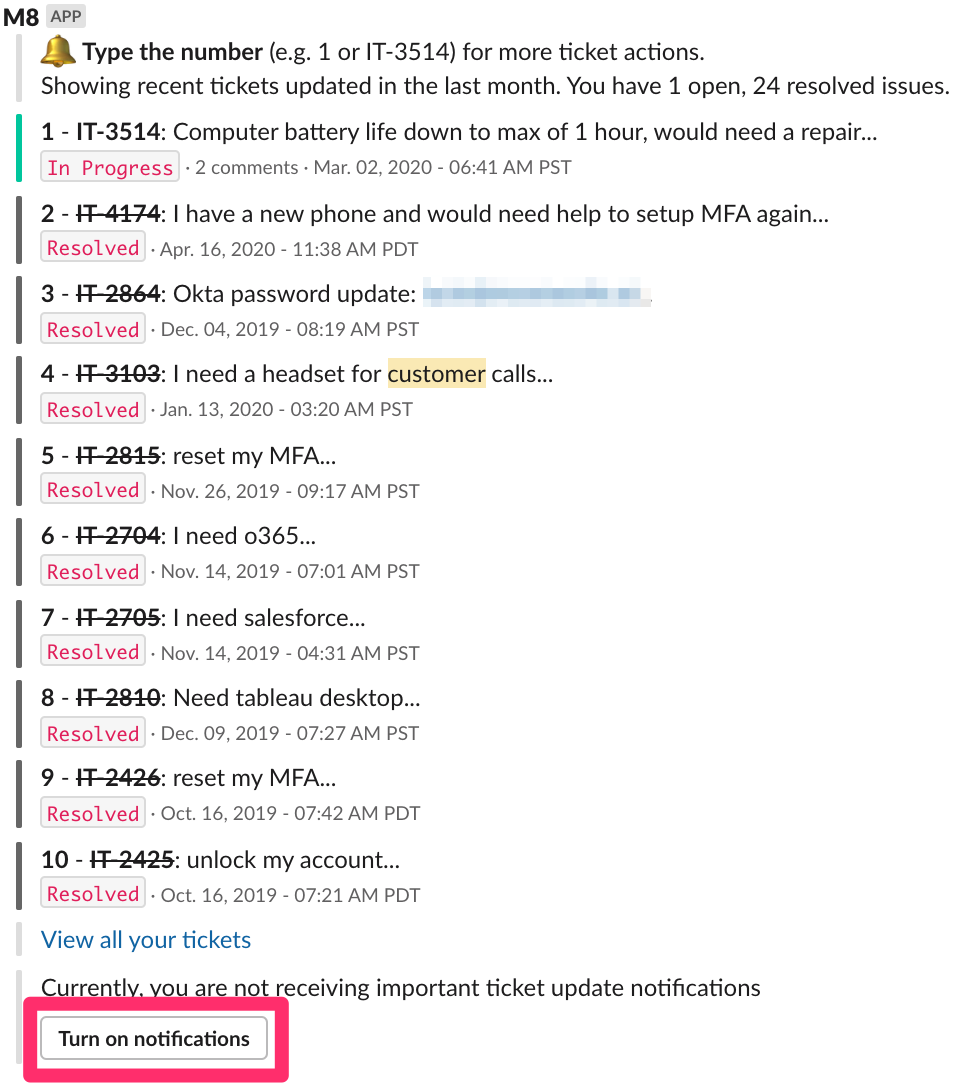
- Type “check status” or something similar to check the status of their tickets.
- Click on Turn on notifications.
Creating / Filing Tickets
Filing a ticket

Long Description + Attachment Support
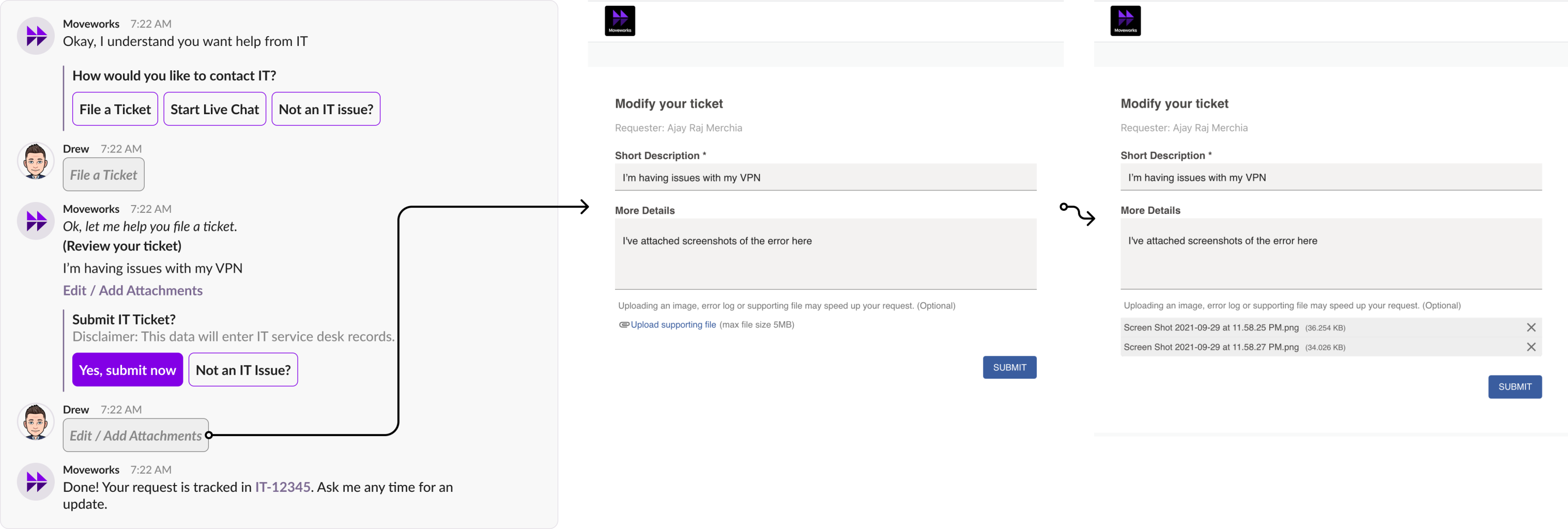
Supported systems: ServiceNow, Jira, Freshservice, Cherwell, Zendesk
For supported systems, users can add attachments to their ticket through Moveworks’ WebUI experience.
When users click on Edit / Add Attachments before submitting their ticket, they will be taken to a browser portal where they can provide a longer description and upload files that will be helpful for agents to resolve the issue.
Each attachment can be at a maximum size of 5 MB. Moveworks will raise an error message to the user if the file is invalid. Multiple files can be selected by holding cmd or ctrl and clicking in the file selection window. If the total size of the files exceeds 5MB, Moveworks will attempt to upload it, but if your ticketing system denies the file, the bot will still create the ticket without the too large file(s).
The following file types can be added as an attachment to a ticket: png, jpg, jpeg, pdf, text, csv, XLSX, XLSM, XLS, XLTX, and XLTM.
See Attachment Handling for more information on how Moveworks manages attachments.
It is not possible to make the long description or attachments mandatory. By default, the long description is a copy of the short description.
Configuration Options
Live Chat

Moveworks can route your employees to live agent chats.
Sensitivity / Disclaimer Footer
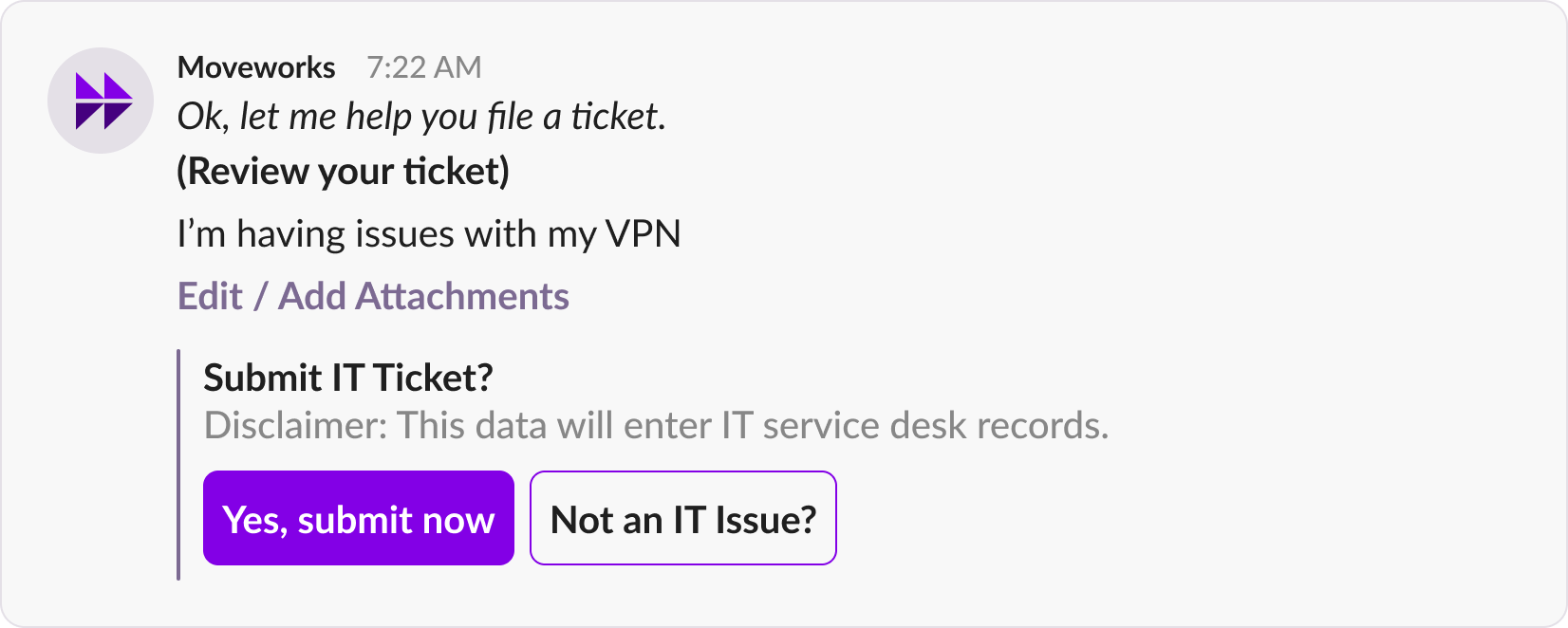
For each domain (e.g. IT or HR), you can provide a custom “sensitivity disclaimer” which is rendered right before the user can file the ticket.
In-Bot Call-Type Triage
For IT tickets, Moveworks can intelligently decide if a ticket should be created as a service request or an incident. This works by defining which ticket should be created by Default when the user does not define a ticket type.
-
You can find this control by navigating to Ticketing > Concierge Tickets > Advanced Settings under the Ticketing Automation Module.
-
Look for the Default ticket type to file option here which will present a list of Ticket Types which can be selected.
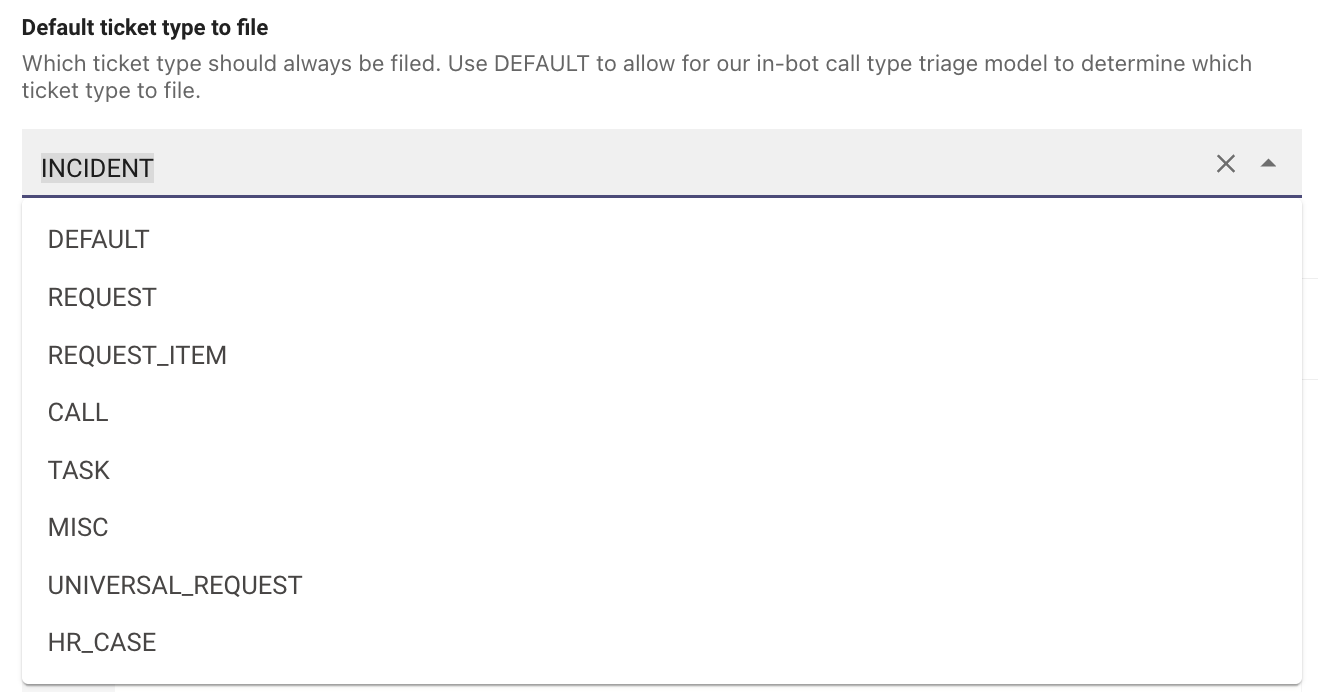
-
We also need to ensure this Ticket Type has been defined in Ticket Mapping. Here is a guide on How to Configure the Ticket Types
Static Field Values
When new tickets are created, you can specify a list of default fields to set (e.g. category, subcategory, configuration item, etc.). These are fixed, regardless of who the user is.
Moveworks does not support setting a default state. This must be done according to the rules of your ticketing system.
User Field Values
When new tickets are created, you can specify a list of fields to set based on the person who is filing the ticket. For example, this can be the requester, the requester’s phone number, department, or other fields that are populated through the user roster.
Follow this Guide on How to Setup Ticketing Fields when Creating a Ticket.
Viewing Tickets
There are three ways in which users can check the status of tickets through the Moveworks bot. Within a message to the bot users can:
- Make a “check status” query
- Mention the ticket ID
- Mention the subject matter of the ticket
A “check status” query
By default, a "Check status" query only works for the requestor of the ticket
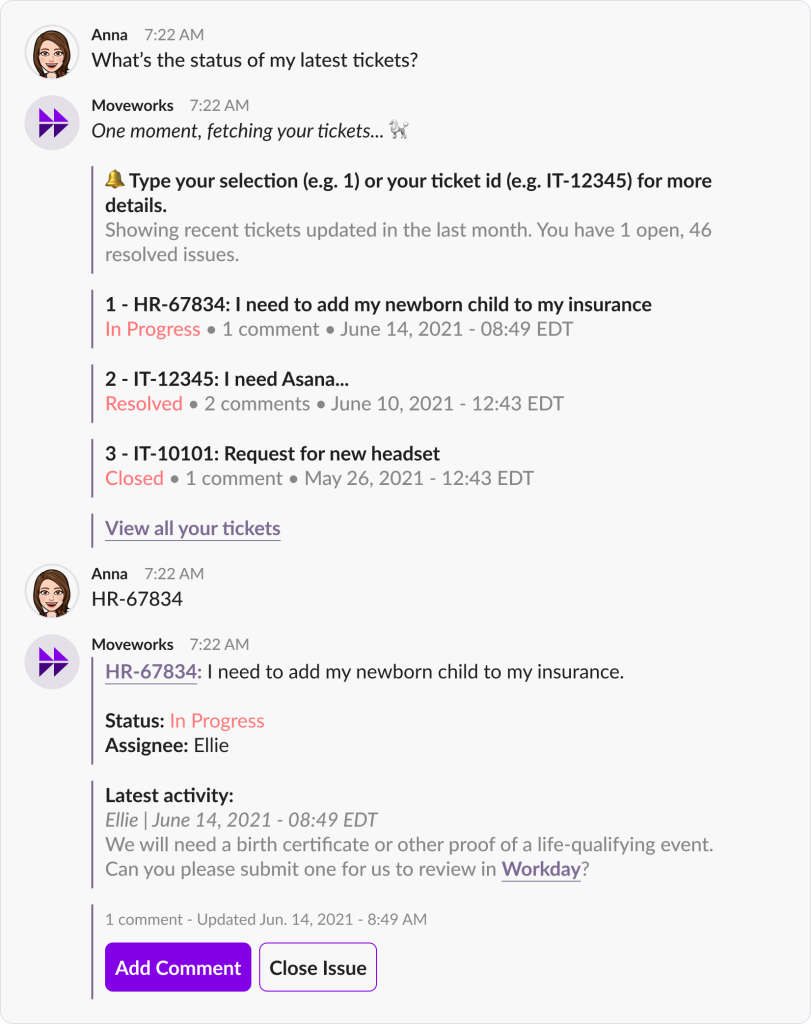
Users can check the status of their tickets by messaging the bot their intention to check on the status of their tickets. Users do not need to mention a specific ticket.
As always, the bot can recognize this intent in a wide variety of language patterns, such as “what’s the status of my tickets?”, “check status”, “show me my open tickets”, etc.
When the bot receives such a message, it fetches the user’s tickets and displays them. The Moveworks bot will show up to 10 tickets in this view. The bot will show tickets that are open first (new, WIP, pending, etc). After open tickets are displayed, then resolved or closed tickets (no more than 30 days old) will be shown.
To see the full status update card of a ticket of interest in the list, the user can either respond with the number shown next to it in the list (i.e. 1, 2, 3, etc.), or the ticket number itself.
Note: This will only show tickets for which the user is the requestor/caller.
If the user is a watcher on a ticket, or was the opener but not the requestor, they must mention the ticket by ID.
Mentioning the ticket by ID
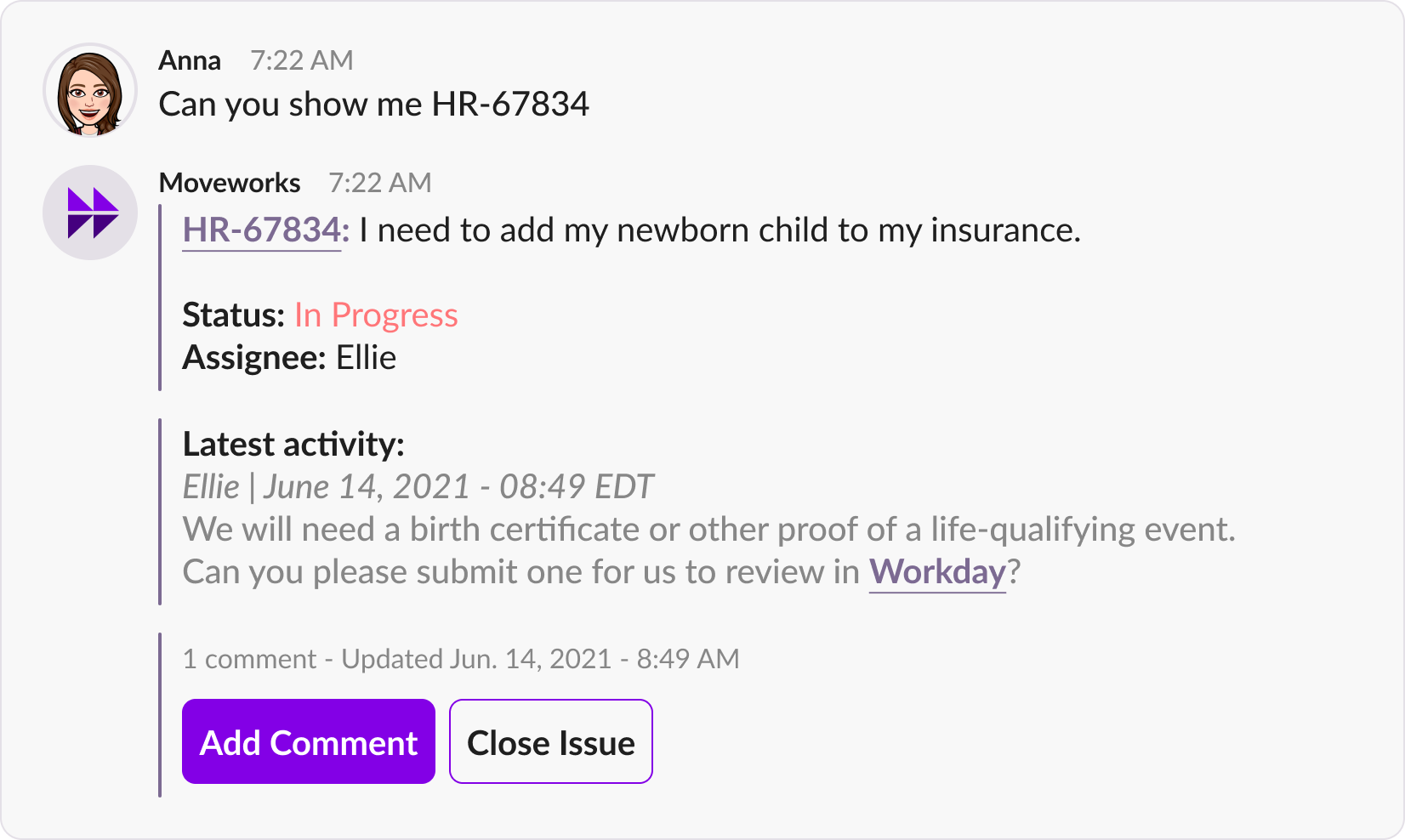
Users can mention a particular ticket number to check on the status of a specific ticket.
If the user is the opener, requestor, or a watcher on the ticket, the bot will return a status update card with the latest update on the ticket.
Mentioning the ticket by subject matter
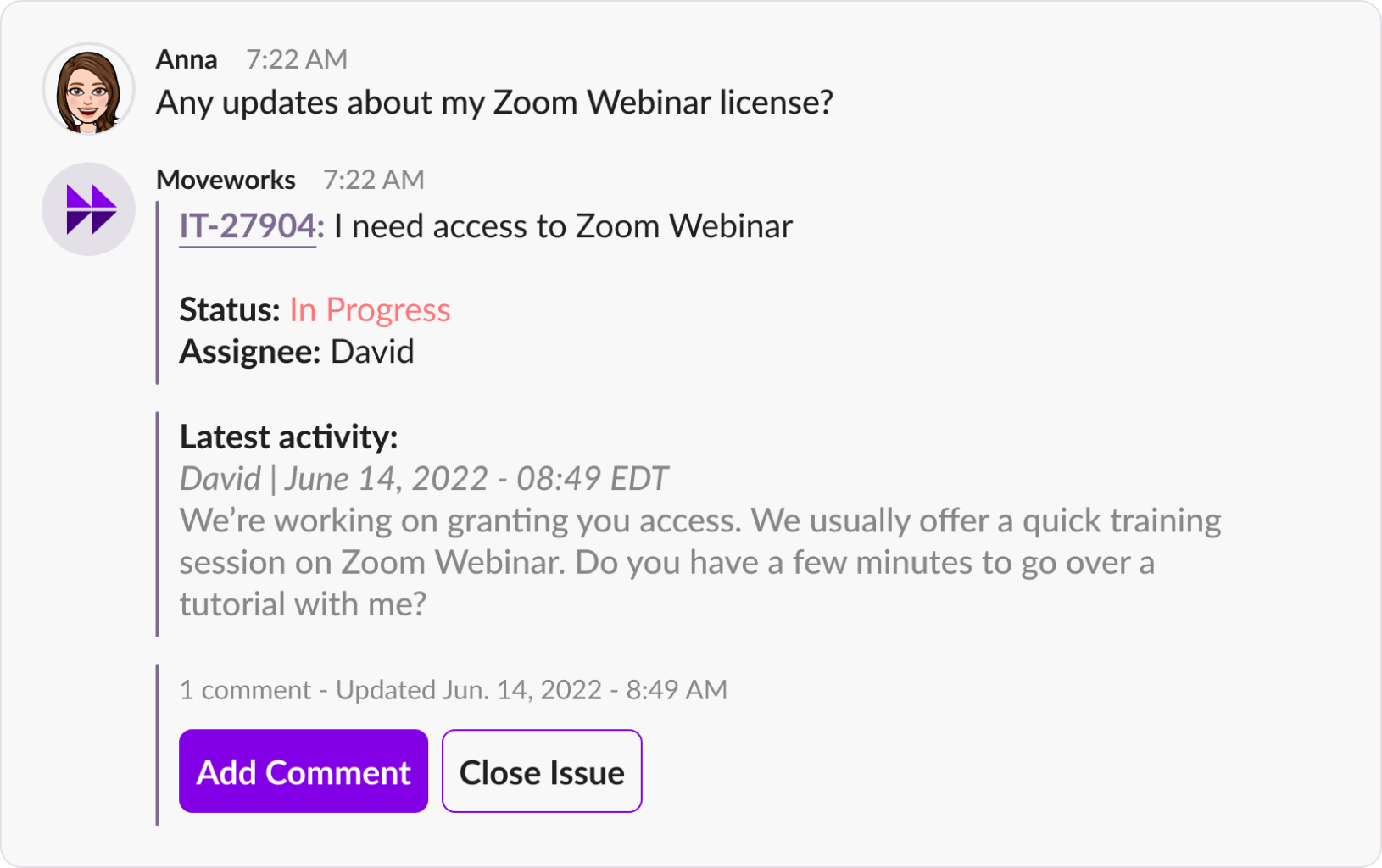
Users can also check the status of a specific ticket of their ticket by describing the subject matter.
Configuration Options
Ticket Link Redirect
Clicking on the ticket link in chat will take you to our WebUI where more details are available.
If a user clicks on See ticket or add attachments in portal, they will be redirected to your ticketing system. This is defined under the Ticket Mapping Config under the Ticket redirect URL format field.
You can also hide the link that will redirect users to your ticketing portal.
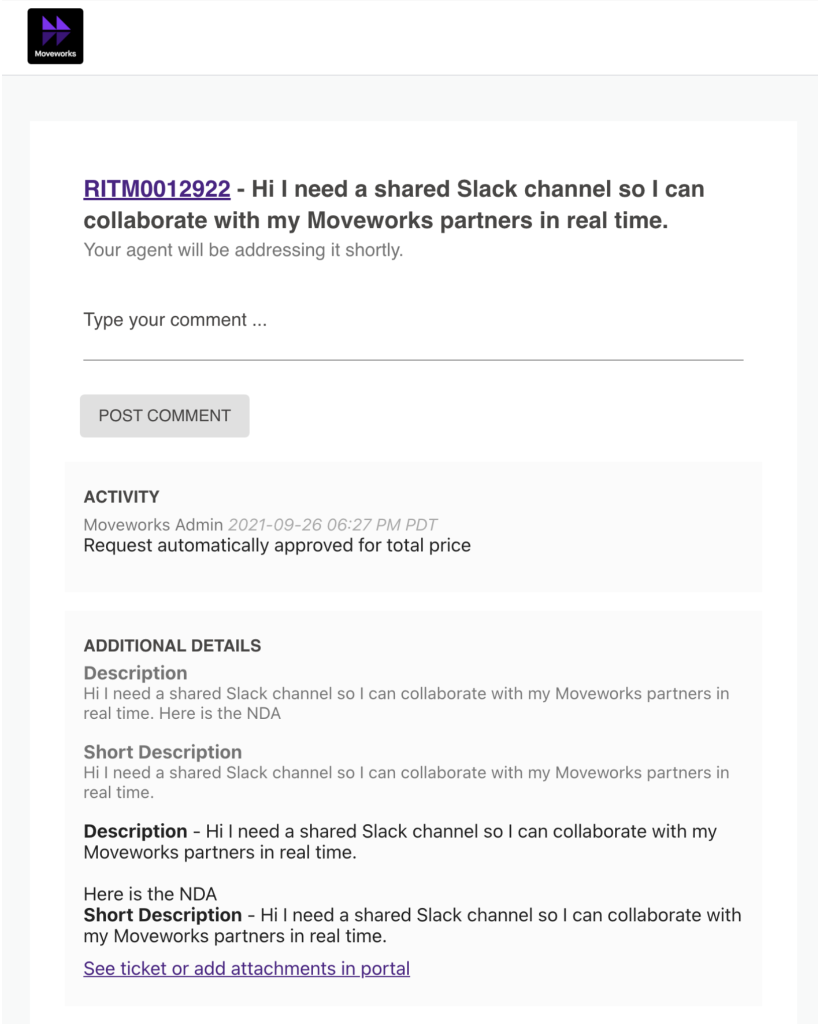
Hide Ticket Assignee
You can optionally hide the ticket’s assignee for all tickets. This will require a change to the Query Ticket Mapper where the attribute is defined, Here is a guide on How to Change or Update the Query Ticket Mapper.
Adding Comments to Tickets
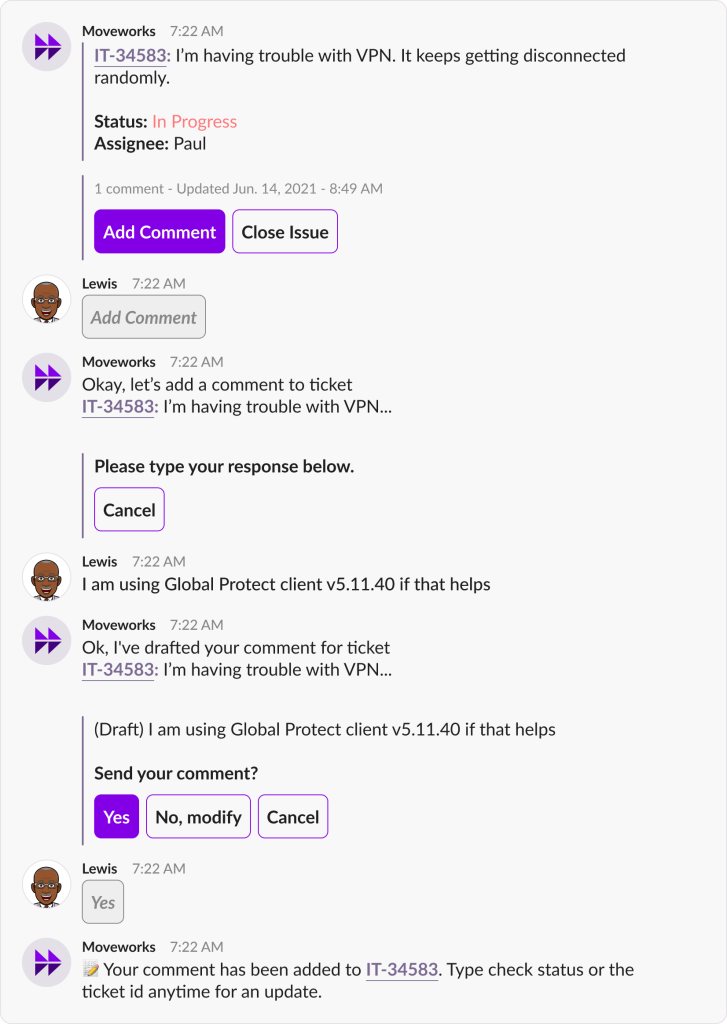
If a user wishes to add a comment to a ticket, they can click on Add Comment. If the user is on a supported system (Slack, Teams) a modal will appear to collect the comment. If the user responds with a comment or is on an unsupported chat system, the dialog experience in the image above will occur.
If the user clicks on No, modify, they will be able to modify the comment in a modal in a supported system (Slack, Teams), or a WebUI experience (in other platforms).
When a comment is added to a ticket, it is attributed to Moveworks (Moveworks does not impersonate the user).
Note: Based on your ticketing system, this may cause users to get emails about their own comments. You should adjust email rules in your ITSM Platform so this does not happen.
Configuration Options
Ticket State Change
By default, if the current state of the ticket is Waiting For User / Pending, Moveworks will update the state to Work In Progress when leaving a comment on behalf of an employee.
You can disable this behavior based on the ticket type (e.g. incident, request, case, etc.)
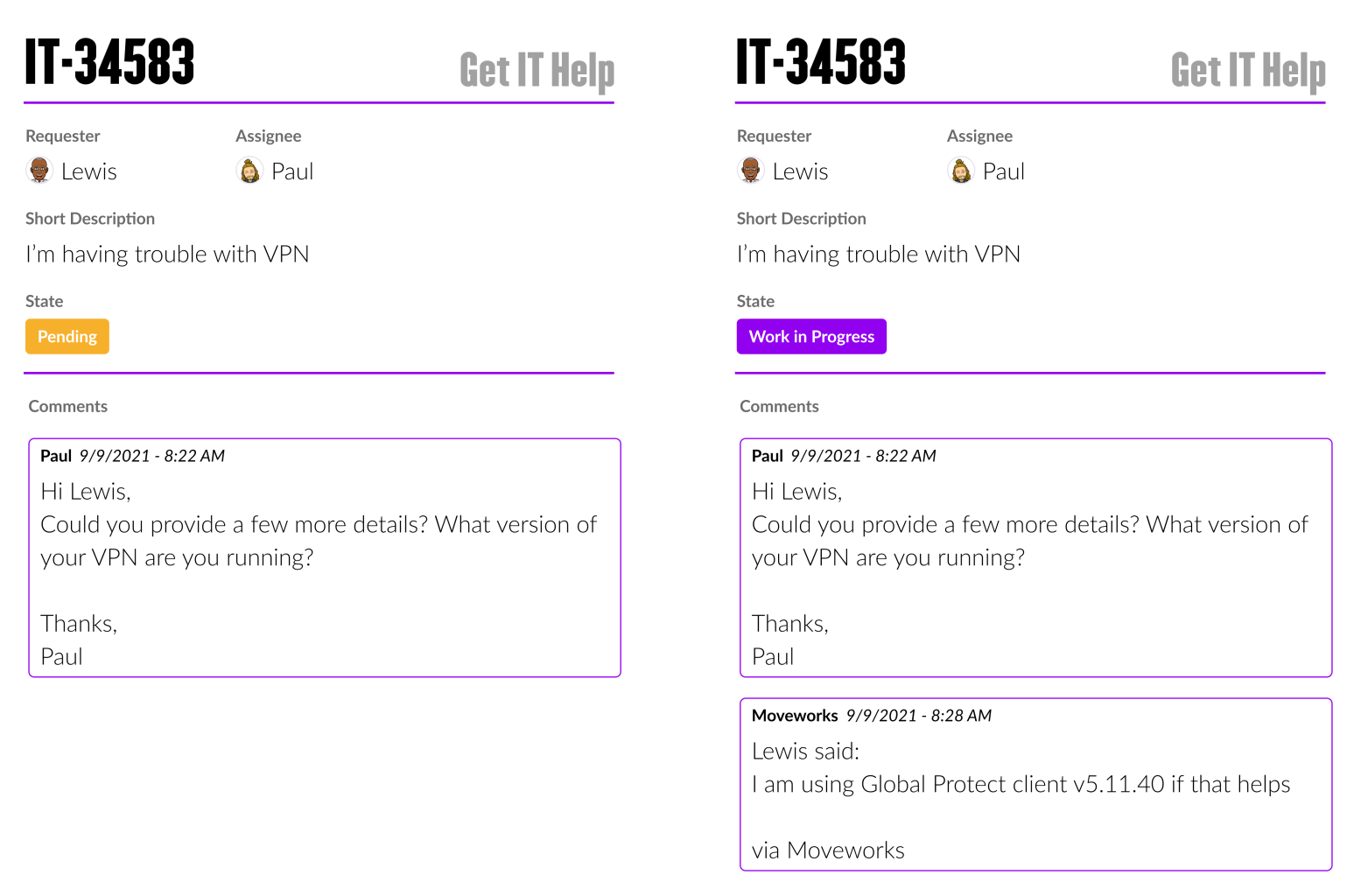
Before comment vs. After comment
Closing/Resolving Tickets
When a user wants to resolve a ticket they can do so in-chat by clicking on Close Issue, and Moveworks will mark the ticket as Resolved. There is no option to mark a ticket as Closed within Moveworks. Most ITSM platforms will set a ticket to closed after it is resolved for a certain amount of days.
Configuration Options
Resolve by adding a comment
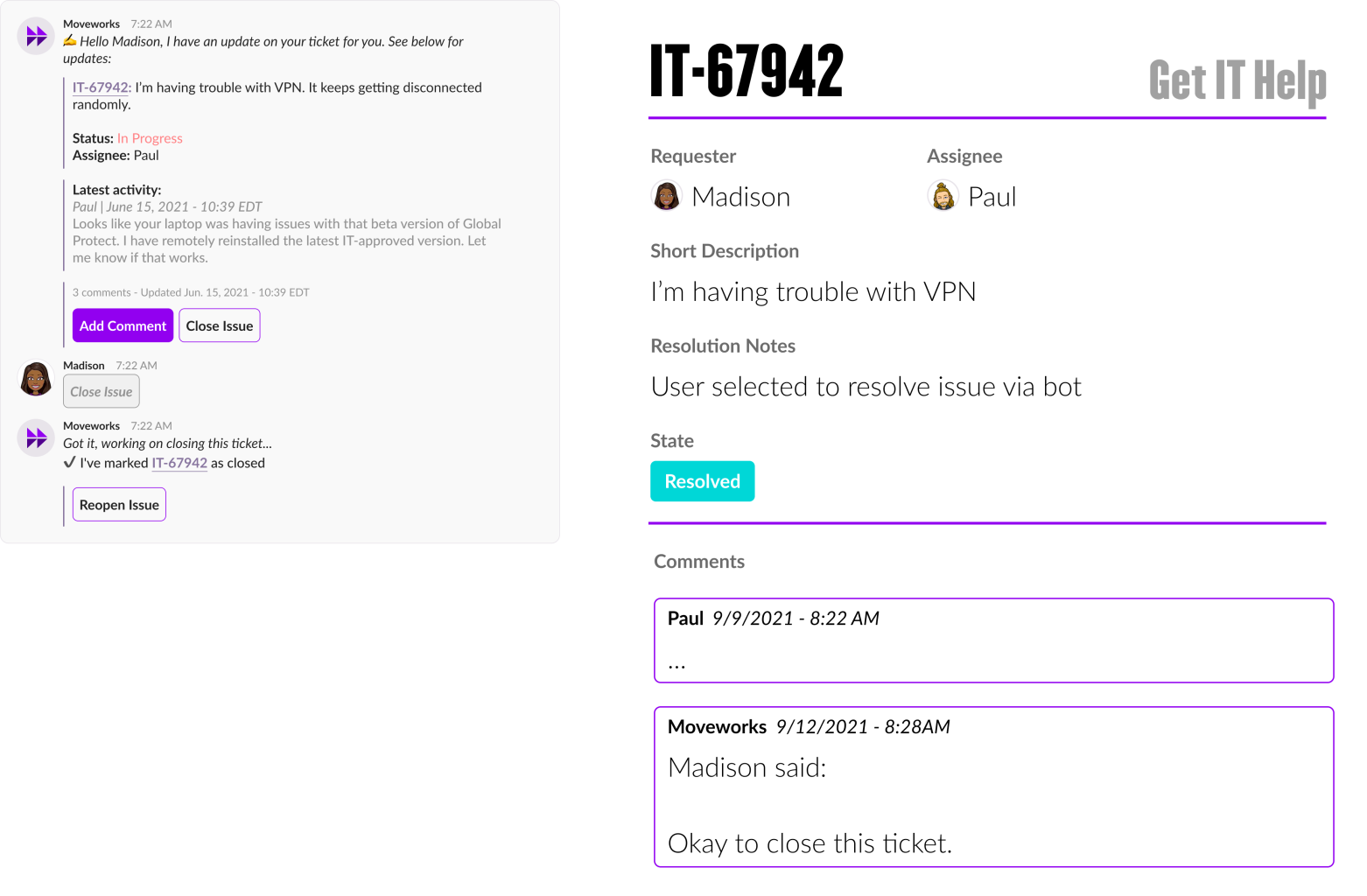
If you do not want Moveworks to change the state of your tickets when an employee wants to resolve the ticket, instead Moveworks can leave a comment for the agent to resolve the ticket.
You can configure this behavior based on the ticket type (e.g. incident, request, case, etc.)
Reopening Tickets
When employees want to reopen their resolved tickets, Moveworks will update the state of the ticket back to New. Moveworks will also give them the option to add a comment to the ticket.
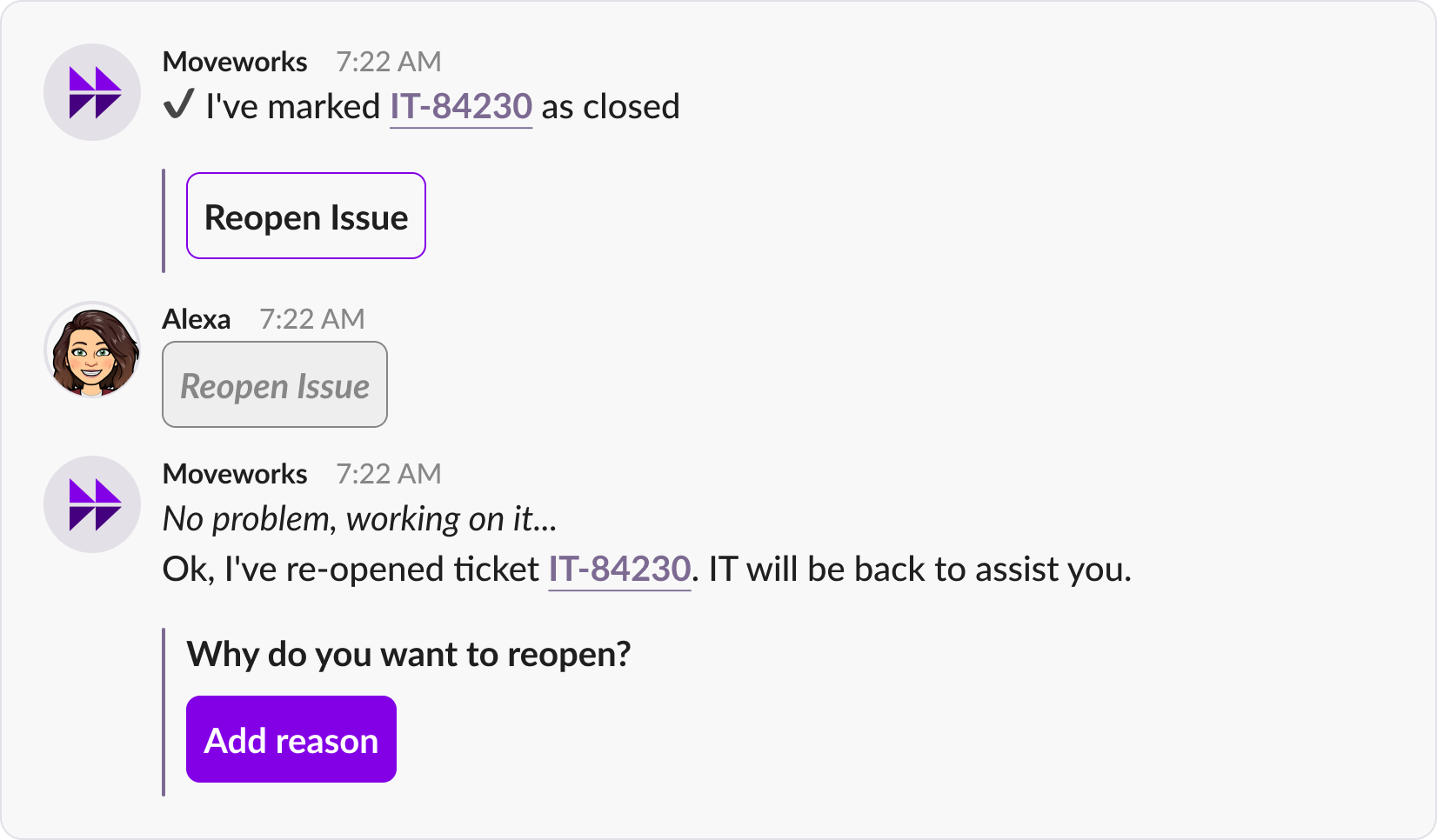
When employees want to reopen their closed tickets, Moveworks will create a new ticket that references the previous ticket in the short description.
Note: The title of the new ticket will be Reopened: {previous short description}
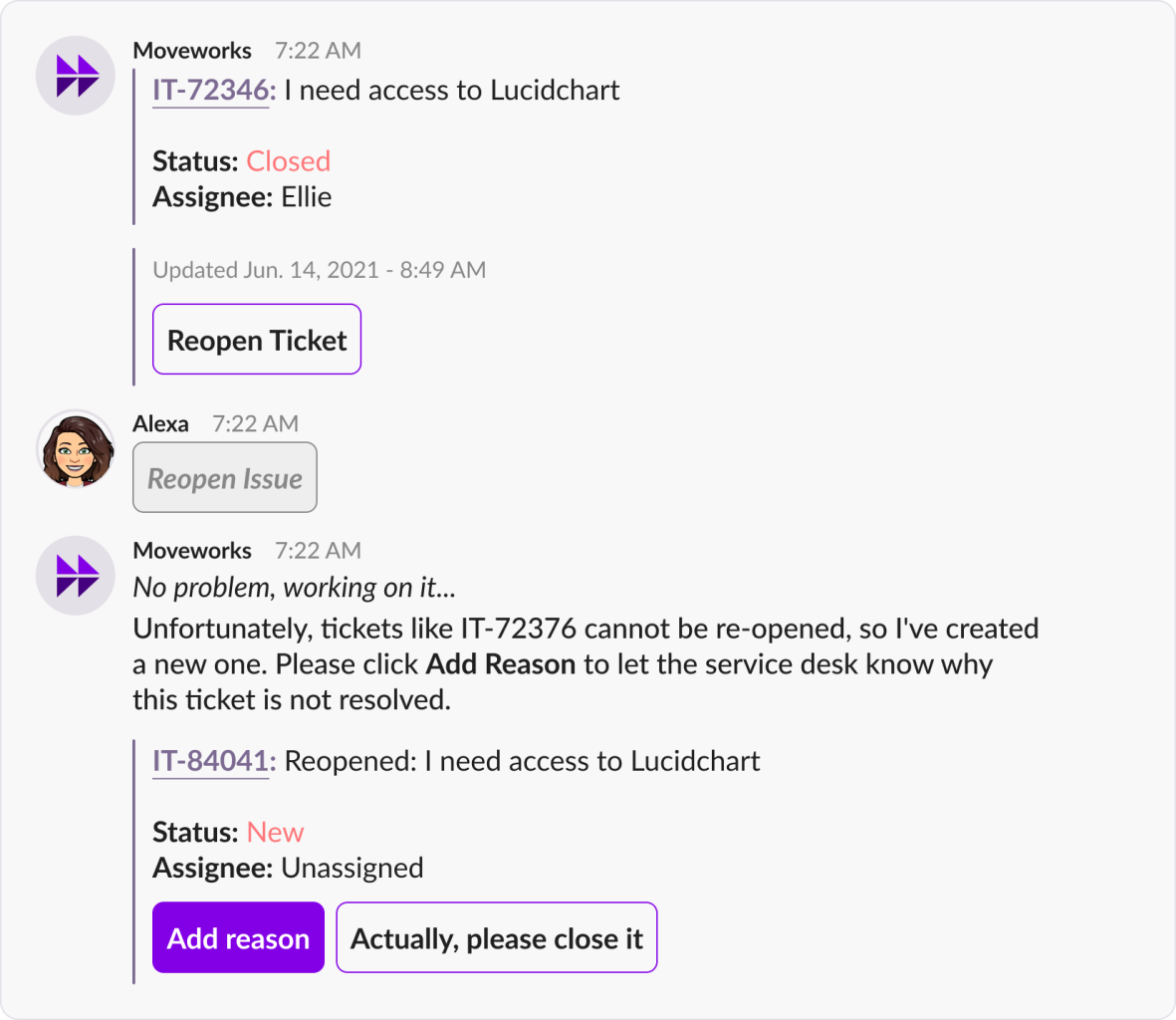
As shown, when the ticket is reopened, it will be unassigned from the current user, but any assignment groups will remain untouched.
Configuration Options
Always reopen as new ticket
Certain tickets should only ever be reopened as a new ticket.
You can configure this behavior based on the ticket type (e.g. incident, request, case, etc.).
You can also configure how the ticket should be reopened (e.g. as the same ticket type).
Hide reopen button for all closed tickets

If you don’t want anyone to be able to reopen a ticket that is closed, you can completely remove the button.
Multi-Domain Concierge
Domain prediction
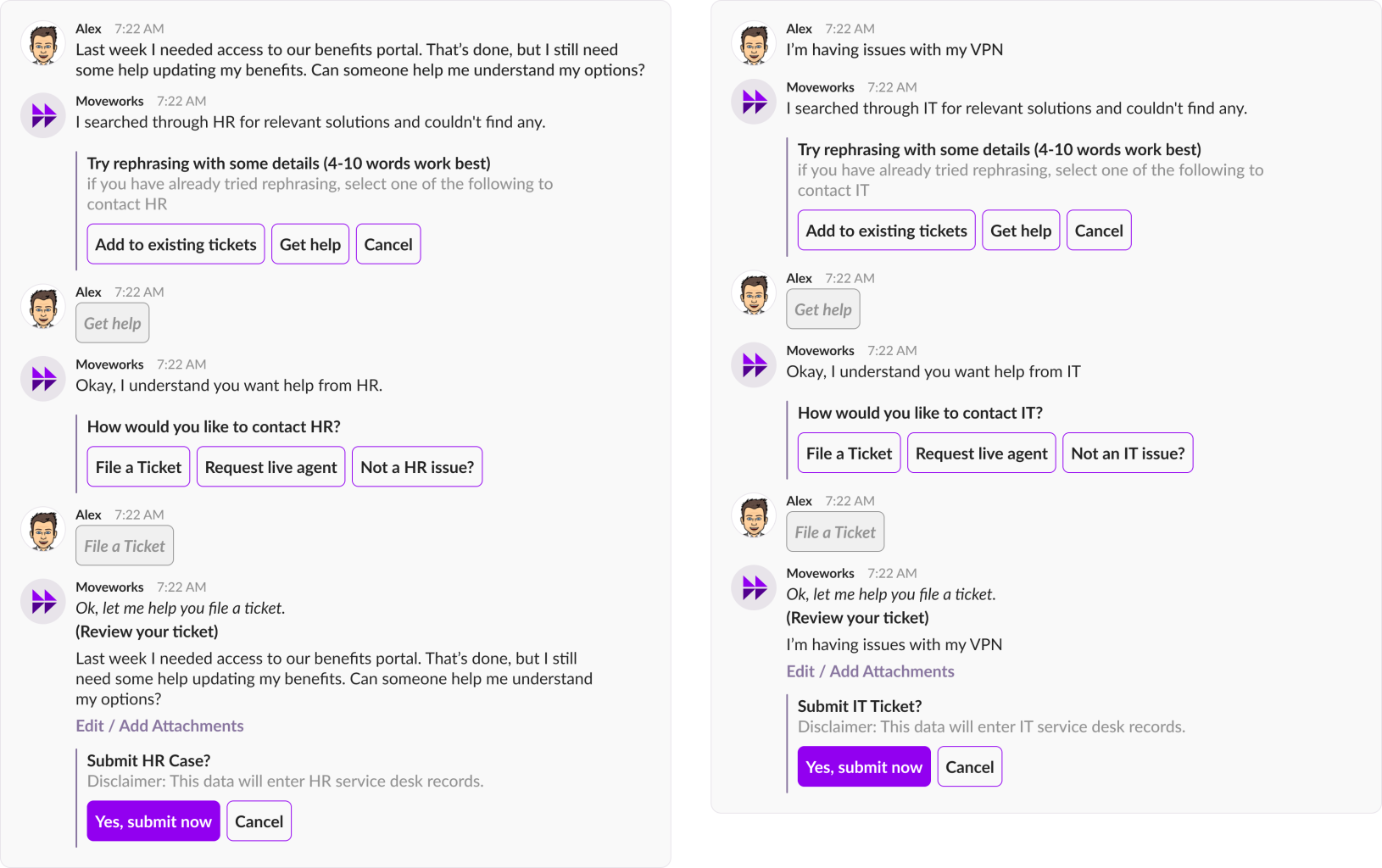
Based on the user’s issue, Moveworks will predict what type of ticket needs to be created. Regardless of the domain, the user experience will be the same.
Domain correction
If Moveworks’ prediction is incorrect, users can correct the domain and file a ticket to the ticketing system of their choice:
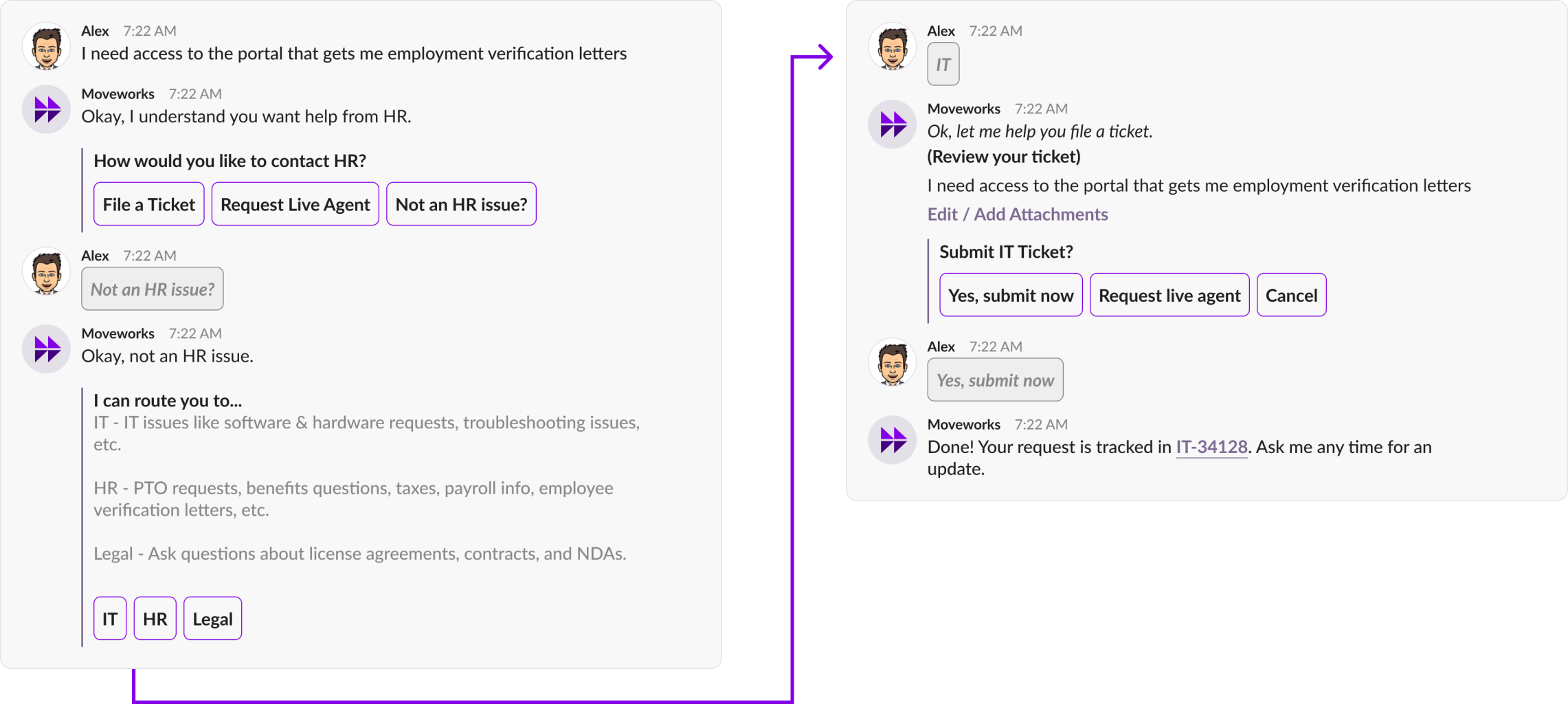
Domain selection
If the user does not provide enough information for Moveworks to predict the domain, the employee can simply select the domain they wish to get help from.
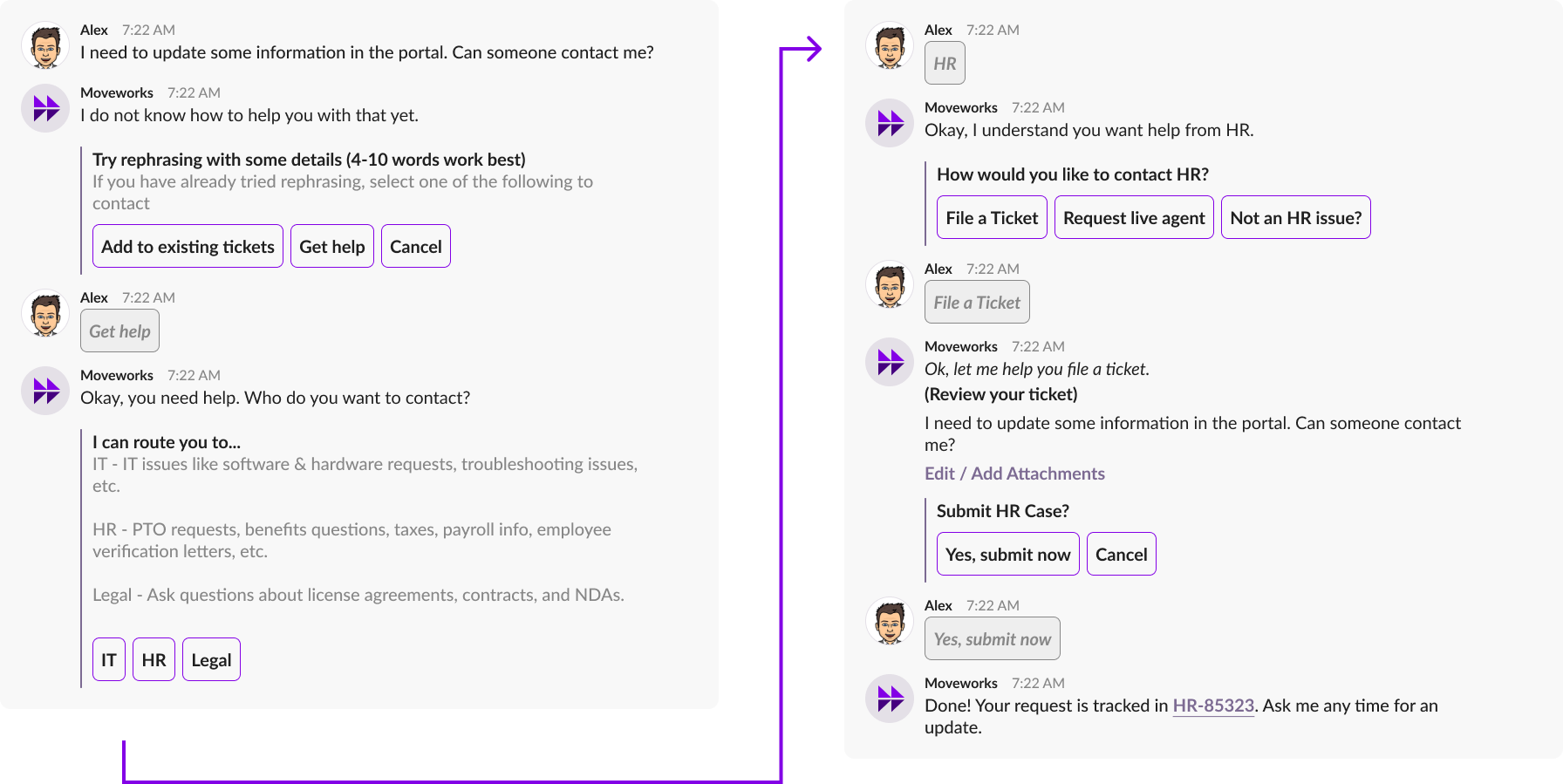
FAQ
Q: When does the Moveworks bot not reach out on a ticket entering the Resolved state?
Resolved state?A: When tickets enter a **Resolved** state, the bot will reach out to the user in most cases. However when a ticket’s state becomes **Resolved** after being reopened again without any new user-facing comments, no notification will be sent. If the bot already notified the user that a ticket was **Resolved**, it will not update the user that a ticket was **Resolved** again if it has been reopened, unless the ticket was resolved a second time with a user-facing comment.
Q: Will the bot alert employees when work notes or internal comments are added to the ticket?
A: No, the bot will only alert employees when a ticket has a user-facing comment.
Q: Will ticket assignees be updated via the bot?
A: No, currently only the requester of the ticket is updated via the bot.
Q:Are there character limitations on the latest activity that is being displayed in the bot?
A: There is no set limit on ticket activities. After 2000 characters, the Moveworks bot will truncate the activity with a link to Read more… which will show all the content (where the content is displayed depends on the configuration of the bot. Please ask your CSM for more details).
Q: Is it possible to turn off notifications by talking to the bot?
A: No, currently the Notification Settings option is only available when a user gets notified.
Q: If a ticket is reopened after being resolved, will the bot notify the user again?
A: If the bot already notified that a ticket was Resolved, it will never update the user that a ticket was Resolved again if it has been reopened, UNLESS the second time it was resolved has a user facing comment.
Q: If the user enters a ticket number that is older than 30 days, will they be able to look up the ticket?
A: Yes, users can still look up the ticket with no time-restriction if they have the ticket number. The time restriction (30 days) only applies to when a user generically asks for the status of their open cases. This time period isn't customizable.
Q: Is it possible to customize which fields are displayed via Check Status / Ticket Lookup, either in the List view or Detail view?
A: No, this isn't customizable today. Moveworks will display certain fields such as the short_description, assignee (if assigned), status and latest activity on the ticket.
Updated 2 months ago